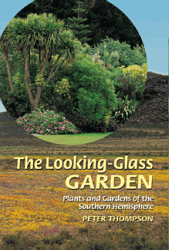|
[Front Page] [Features] [Departments] [Society Home] [Subscribe]

A Good Read
.....what's worth a look?
Reviews in this issue cover Colour Guide to Spring Wildflowers of Western Australia by Eddy Wajon, The Looking Glass Garden - Plants and Gardens of the Southern Hemisphere by Peter Thompson and Is it a Weed? A Weed Identification Guide for Central Victoria by Ern Perkins (CD-ROM) |
 |

 
Colour Guide to Spring Wildflowers of Western Australia
Eddy Wajon
Published by Wajon Publishing
Company, Winthrop Western Australia,1999-2001.
Three Parts published to date:
- Part 1 Kalbarri and the Goldfields (1999)
- Part 2 Perth and the southwest (2000)
- Part 3 Esperance and the wheatbelt (2001)
Each Part around 120 pages with approximately 220 colour illustrations.
$A20.00 per part.
Reviewed by Tony Cavanagh
This set of guides is not readily available in the east but we found copies in many tourist information centres and bookshops in Western Australia last year. It is the latest in the seemingly never-ending list of books produced to help the reader identify at least some of the more than 12,000 flowering plants found in Western Australia and the author has adopted a novel approach.... The wildflowers are grouped by colour rather than by family or genus. The colours chosen are those of the rainbow-red, orange, yellow, green and blue. Pink flowers follow red flowers and white flowers follow yellow. Mauve flowers are included with pink, brown with orange, cream with white, black with green and purple or lilac flowers are included with blue. Some individual flowers which have several colours are included in the most obvious colour, eg. "eggs and bacon" flowers are found under yellow. Many plants have more than one colour form; only one colour is illustrated but the others may be found by checking the lists of multi coloured flowers which is included. To help users, there is a strip of colour along the edge of the pages to mark each colour section.
Within each section, the grouping is alphabetical by scientific name although common names are included wherever possible. Descriptions are very brief and non-technical and tlie area and soil type where plants may be found are included.
A feature very helpful to tourists not familiar with the Western Australian flora is the inclusion of a box against each plant showing the date and place where the photograph was taken, with room to add further observations. Further assistance is provided by two maps, one showing the main towns and roads and a second index map showing towns in the area of Western Australia covered by the Part and highlighting "good flora" roads. Unfortunately, because the books are A5 size, the maps are too small to be read easily and could benefit in future editions from being enlarged to a fold-out size. The book concludes with a combined scientific and common name index and a short list of references.
Eddy Wajon should be congratulated on producing this set of very useful guides. They are aimed at people with little knowledge of botany or of the Western Australian flora so the author has chosen relatively common plants which can be seen by the roadside between July and November.
The usefulness of guides such as these depends on the quality of the photographs and the accuracy of the names. On both counts, they score highly. Eddy Wajon is a well-known orchid photographer who has provided numerous photographs for orchid, tourist and landscape calendars. The pictures are sharp and clear although some colours such as the oranges and yellows on pages 44 and 45 of Part 3 have reproduced poorly in printing.
The specimens have been identified against the holdings of the Perth Herbarium and the work has been checked by a professional botanical editor so the books can be used with confidence. I particularly liked the simple colour arrangement approach although of course, given the 12,000 flowering plants in Western Australia, it is almost inevitable that many of the plants one sees by the roadside will not be included in the guides.
Highly recommended.
Reproduced from Growing Australian, newsletter of the Australian Plants Society (Victoria), June 2002.

 
The Looking Class Garden - Plants and Gardens of the Southern Hemisphere.
Peter Thompson
Published by Timber Press, Portland, Orgeon, USA, 2001.
451 pages, 151 color photos, 4 maps, 160 x 235mm, hardcover.
About $A120.
Reviewed by Mary King
 
This book is part travelogue, part inspiration and partly a practical book on plants and how to grow them. The title and theme is taken from Lewis Carrol's book where Alice stepped through the looking glass into a world where nothing is as expected. Australian readers will enjoy seeing our plants through the eyes of a northern hemisphere horticulturist who is targeting his book at northern hemisphere readers accustomed to growing delphiniums, lupins and hostas.
Tasmanian readers will feet a surge of patriotic pride to read about our Telopea truncata (Tasmanian Waratah) as a plant 'gardeners would be ready to die for'. Eucryphia lucida is also mentioned together with its cultivars 'Pink Cloud', 'Gilt Edge' and 'Leatherwood Cream'. In another chapter you will come across a photograph taken in the garden of Australian Plants Society members John and Marion Simmons (no, it isn't an Acacia but a Banksia blechnifolia from the chapter on patio gardens). In another section Clematis aristata x gentianoides is mentioned. (This plant is one of APS member Kris Schaffer's 'babies' that she came across in in a batch of seedlings while working at Plants of Tasmania Nursery).
Different plants are grouped in chapters such as "Gardens in Sunshine", "Reflections of Nature", "Oases with Trees", "Shrubs for Sunlit Spaces", "Flowers of the Veld and Bush", "Plants with Attitude", "Gardens by the Seaside", "Gardens in Shadow", "Flowers of the Forest", "Gardens Without Flowers" and "Gardens in Containers". Plants from Australia, Chile, South Africa and New Zealand are mentioned in each chapter.
This book is lavishly illustrated with excellent photographs ranging from plants close up to how to grow them in the landscape. There is something for everyone, whether you are searching for Inspiration or just wanting to read about plants. The book is well written and easy to read. However there is a lot of information and you can't gobble it all up in one sitting. The book is printed on glossy paper and is fairly
thick which makes it heavy to hold and not so comfortable for reading in bed!
Peter Thompson was for many years Head of the Physiology Department at the Royal Botanical Gardens at Kew; he has also been proprietor of Oldfleld Nurseries and Director of the Garden School, so he certainly knows and appreciates his plants and can inspire others through his writing. This is a very worthwhile addition to your bookshelf.
Reproduced from Eucryphia, newsletter of the Australian Plants Society (Tasmania), July 2003.

 
Is it a Native? A Weed Identification Guide for Central Victoria
Ern Perkins
CD-ROM for Windows and Macintosh (requires Adobe Acrobat Reader)
Published by Castlemaine Field Naturalists Club Inc., PO Box 324, Castlemaine Vic 3450.
$A5.00, or $A7.00 posted.
Reviewed by Andrea Dennis
 
This CD is simple and logical to use. It will on on both IBM and MAC. It requires Adobe Acrobat for it to run - this programme is included on the CD together with instructions for installing it. Instructions are on the front inside cover.
The menus are in easily identifiable pictures, with a brief description of the type of plants in the category (eg. pea flowers). The secondary menu lists the habit to help with your identification.
You can go back to the main menu from whatever page you are on with the click of a mouse. Exotic plants are marked with an *. Occasionally a native plant is listed as a weed species and marked with +. This does include some species native to other parts of Victoria, so anyone using this CD anywhere else in Victoria would need to be aware of this. You don't need to be a botanist to use it, common names are used in the menu, but the botanical name is listed on the description page.
Over 450 species are illustrated. Scientific names, common names and family are listed together with the distribution in the wild, key identification features and notes.
At $5 this CD is excellent value for money.
Reproduced from Growing Australian, newsletter of the Australian Plants Society (Victoria), June 2003.

[Front Page] [Features] [Departments] [Society Home] [Subscribe]
Australian Plants online - September 2003
Association of Societies for Growing Australian Plants
|